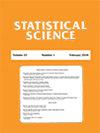有序变量三向对应分析的对称与非对称变体
IF 3.9
1区 数学
Q1 STATISTICS & PROBABILITY
引用次数: 2
摘要
在多维数据分析的框架下,本文提出了三元对应分析的对称和非对称变体,这些变体适用于由序数变量构造三元列联表的情况。特别地,可以使用一般的递推公式对这样的变量进行建模,以生成正交多项式向量,而不是来自奇异值分解的可能的三元扩展之一的奇异向量。正如我们将看到的,这些多项式,到目前为止一直被用来分解具有有序变量的双向列联表,也构成了一个替代的正交基础,用于建模三元列联表中的对称、非对称关联和可预测性。将强调建模和绘图的后果。本文章由计算机程序翻译,如有差异,请以英文原文为准。
Symmetrical and Non-symmetrical Variants of Three-Way Correspondence Analysis for Ordered Variables
. In the framework of multi-way data analysis, this paper presents symmetrical and non-symmetrical variants of three-way correspondence analysis that are suitable when a three-way contingency table is constructed from ordinal variables. In particular, such variables may be modelled using general recurrence formulae to generate orthogonal polynomial vectors in-stead of singular vectors coming from one of the possible three-way extensions of the singular value decomposition. As we shall see, these polynomials, that until now have been used to decompose two-way contingency tables with ordered variables, also constitute an alternative orthogonal basis for modelling symmetrical, non-symmetrical associations and predictabilities in three-way contingency tables. Consequences with respect to modelling and graphing will be highlighted.
求助全文
通过发布文献求助,成功后即可免费获取论文全文。
去求助
来源期刊

Statistical Science
数学-统计学与概率论
CiteScore
6.50
自引率
1.80%
发文量
40
审稿时长
>12 weeks
期刊介绍:
The central purpose of Statistical Science is to convey the richness, breadth and unity of the field by presenting the full range of contemporary statistical thought at a moderate technical level, accessible to the wide community of practitioners, researchers and students of statistics and probability.
 求助内容:
求助内容: 应助结果提醒方式:
应助结果提醒方式:


